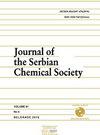Binuclear azide-bridged hydrazone Cu(II) complex: Synthesis, characterization and evaluation of biological activity
IF 1
4区 化学
Q4 CHEMISTRY, MULTIDISCIPLINARY
引用次数: 0
Abstract
The condensation product of 7-acetyl-6-azaindole and Girard's T reagent ((E)-2-(2-(1-(1H-pyrrolo[2,3-c]pyridin-7-yl)ethylidene)hydrazineyl)- N,N,N-trimethyl-2-oxoethan-1-aminium, HL ligand) was used as a ligand in the reaction with Cu(BF4)2?6H2O and NaN3. The reaction led to the formation of a binuclear Cu(II) complex containing two end-to-end (di-m-1,3-N3) azide bridges, as well as two NNO-donor hydrazone ligands, forming an axially elongated square pyramidal geometry around each Cu(II) center. This end-to-end (di-m-1,3- N3) azide bridge binding mode has not yet occurred in Cu(II) complexes containing the NNO-donor hydrazone ligands, which makes the structure of the complex even more interesting for further studies. The complex was characterized by elemental analysis, IR spectroscopy and X-ray crystallography, and it was found that it crystallizes in the triclinic space group P-1 with the asymmetric unit comprising one Cu(II) centre, zwitterionic ligand L, one azide (N3?) ligand, and BF4? counter anion. Examination of antimicrobial activity of the complex shows higher antifungal and antibacterial activity towards tested Gram-positive bacteria in comparison to the hydrazone ligand, with the antifungal activity of the complex even being comparable to the activity of amphotericin B.双核叠氮化物桥接腙Cu(II)配合物:合成、表征及生物活性评价
以7-乙酰-6-叠氮酚与Girard T试剂((E)-2-(2-(1-(1h -吡咯[2,3-c]吡啶-7-基)乙基)肼基)- N,N,N-三甲基-2-氧基-1-胺,HL配体)的缩合产物为配体与Cu(BF4)2?6H2O和NaN3。该反应生成了双核Cu(II)配合物,包含两个端对端(di-m-1,3- n3)叠氮化物桥,以及两个nno给体腙配体,在每个Cu(II)中心周围形成轴向拉长的方形金字塔几何结构。这种端到端的(di-m-1,3- N3)叠氮化物桥结合模式尚未在含有nno给体腙配体的Cu(II)配合物中发生,这使得配合物的结构更加有趣,值得进一步研究。通过元素分析、红外光谱和x射线晶体学对该配合物进行了表征,发现该配合物在三斜空间群P-1中结晶,其不对称单元由一个Cu(II)中心、两性离子配体L、一个叠氮化物(N3?)配体和BF4?反离子。对该复合物的抗菌活性检测表明,与腙配体相比,该复合物对革兰氏阳性细菌具有更高的抗真菌和抗菌活性,其抗真菌活性甚至可与两性霉素B的活性相媲美。
本文章由计算机程序翻译,如有差异,请以英文原文为准。
求助全文
约1分钟内获得全文
求助全文
来源期刊
CiteScore
1.80
自引率
0.00%
发文量
76
审稿时长
1 months
期刊介绍:
The Journal of the Serbian Chemical Society -JSCS (formerly Glasnik Hemijskog društva Beograd) publishes articles original papers that have not been published previously, from the fields of fundamental and applied chemistry:
Theoretical Chemistry, Organic Chemistry, Biochemistry and Biotechnology, Food Chemistry, Technology and Engineering, Inorganic Chemistry, Polymers, Analytical Chemistry, Physical Chemistry, Spectroscopy, Electrochemistry, Thermodynamics, Chemical Engineering, Textile Engineering, Materials, Ceramics, Metallurgy, Geochemistry, Environmental Chemistry, History of and Education in Chemistry.

 求助内容:
求助内容: 应助结果提醒方式:
应助结果提醒方式:


